1967 Monaco Grand Prix race report: Hulme the victor on black day

Denny Hulme took his first win of the season from Brabham
Motorsport Images
It is now just one whole year since the present Grand Prix Formula really got under way, for this time last year the Monaco Grand Prix saw the first big outing of the 3-litre Formula One cars and while 1966 saw some ups and downs 1967 is showing terrific progress. Although this year’s Monaco GP was the first Championship event in Europe it was not the first in 1967 for back in the winter the South African GP was held, though in character it was a 1966 event.
With the Monaco starting grid limited to sixteen cars, invitation entries were only given to manufacturers who have been building Grand Prix cars for at least three years, the rest of the entry having to fight among themselves during practice for the remaining places, and these included the AAR Eagle-Weslake team and McLaren. The Owen Racing Organisation entered Stewart with a 2-litre V8 Tasman BRM, and Spence with a revised H16 BRM as used at Oulton Park, and they had another similar H16 car for Stewart if he wanted it.
Honda Racing entered Surtees and he had two V12-cylinder cars to choose from, both to the same basic specification but differing in detail, the spare one being virtually brand new. They both had entirely new 5-speed gearboxes with a rearrangement of the crown-wheel layout and the gear shafts, that provides lower friction losses and the whole unit was lighter than the previous one. They were also using new cast alloy wheels, with wider rims than before, now made in Japan whereas previous wheels were made by Halibrand in America.
The Brabham team had their two 1966 cars for Brabham and Hulme, the leader having the “interim” engine, of old bottom end and new cylinder heads, but they had a brand new all-Repco engine in a box in case it was needed. This had a Repco-designed aluminium crankcase and block in place of the basic American block used in the past, and it had the latest cylinder heads with inlet and exhaust ports in the vee of the engine, but still with single overhead camshaft to each bank of cylinders.
The Cooper Car Company entered Rindt and Rodriguez with Maserati-engined cars, unchanged to any great extent from the end of last year, but they had a spare car, which was also a 1966 monocoque chassis, with a brand new Maserati engine installed. This used the bottom end of the current 12-cylinder engine but had interesting new cylinder heads with three valves per cylinder.
* * *
There are two inlet and one exhaust and the angle between the inlet and exhaust valves is very small so that the two camshafts on each head lie close together and are under one cam cover, not unlike the Eagle Weslake cylinder head. The inlet ports, fed by Lucas injection, lie in the vee of the engine and the exhaust ports are on the outside, while the twin sparking plugs per cylinder are under the exhaust ports in the side of the combustion chamber instead of in the more usual central position. Exposed toothed-belts at the front of each inlet camshaft drive twelve-pole spark distributors, ignition being by Lucas transistor system.
All three cars were using ZF gearboxes and new one-piece drive shafts with rubber “doughnut” couplings were being tried for the first time, in view of the hard life that the Monaco circuit gives the transmission system. There was also a smaller and lighter radiator being experimented with and some interesting new fabricated magnesium wheels, but these stayed in the garage and were not used.
With the V8 Cosworth-Ford engine not being ready Team Lotus had to rely on old material, Clark having the Lotus 33 from last year with 2-litre Coventry-Climax V8 engine and ZF gearbox and Graham Hill having the Lotus 33 with 2-litre BRM V8 engine and Hewland gearbox.
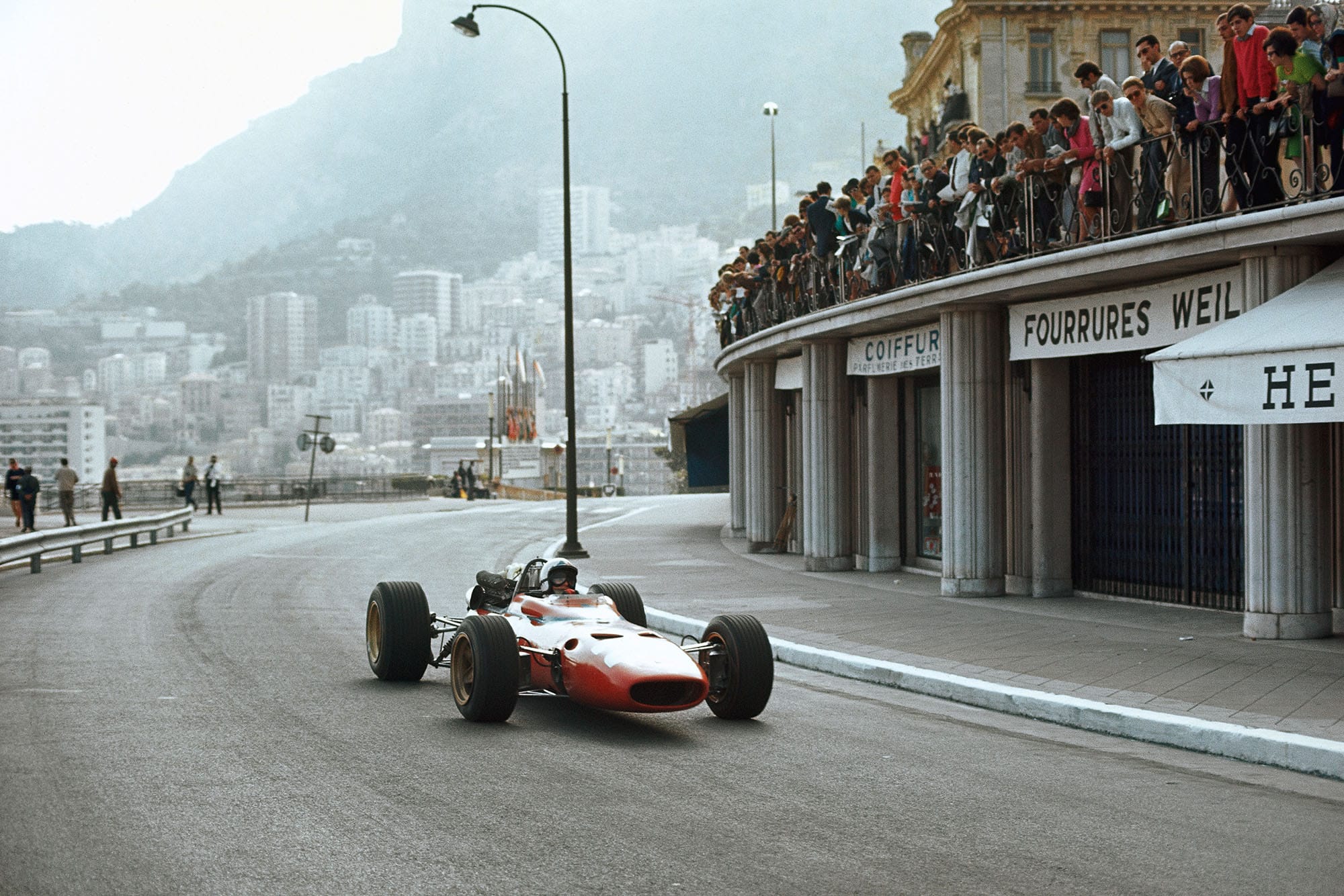
Amon heads through Massenet
Motorsport Images
The Ferrari team had three entries but actually only took up two of them, for Bandini and Amon, both cars having the new 36-valve engines with central exhaust system, as first appeared at Brands Hatch earlier this season. They were fitted with new nose cowlings and cockpit surrounds with faired-in rear-view mirrors and very small Perspex windscreens, There were enormous air scoops to the front brakes, a small one to the driver’s feet and at the back great fog-horn like air scoops to the inboard rear brakes.
This made a total of eleven invited entries leaving five places to be decided among the remaining ten entries, but these were reduced to eight when neither Bonnier nor Ligier turned up with their private Cooper-Maseratis.
The remaining eight comprised Gurney and Ginther with the two Eagle-Weslake V12-cylinder cars, as raced at Brands Hatch, looking resplendent in highly polished and chromium plated finish, with blue and silver bodywork; Siffert with the Walker/Durlacher Cooper-Maserati V12 fresh from a fine drive at Silverstone; McLaren with his compact little monocialue Formula 2-based car, with 2-litre BRM V8 engine and Hewland gearbox, the car being fitted with a short nose cowling and pannier fuel tanks, so that it looked almost as wide as it was long.
Anderson was with his Brabham with 2.7-litre 4-cylinder Coventry-Climax engine; Courage with a 2-litre V8 BRM car running under the Parnell banner; and two works Matra entries driven by Beltoise and Servoz-Gavin, those being Formula 2 cars with Cosworth-Ford FVA 16-valve engines and Hewland gearboxes and both cars had to carry ballast to bring them up to the minimum Formula One weight. Of these eight the fastest five during the three practice periods would join the select seven to make up the field for the 25th Monaco GP.
Qualifying
Activity began on Thursday afternoon, with Rindt being first away in the Cooper with the new Maserati engine and Surtees was right behind him with one of the Hondas. Pretty soon everyone was under way and the only absentees were Clark and Hill, their cars not having arrived due to the transporter getting held up by a shipping strike in the Channel.
The lap record for the Monaco circuit was set up last year by Bandini with a Ferrari in 1min 29.8sec during the race, and in practice Clark was the fastest with 1min 29.9sec so it was reasonable to view 1min 30.0sec as bogey time for the factory runners in view of the general progress over the past twelve months.
“Hulme was in fine form and a joy to watch as he took the hairpins in a big tail slide”
The general pace while everyone was settling in was around 1min 35sec, but gradually the tempo increased and it was Stewart who was setting the pace with the 2-litre BRM McLaren had not gone far before a rear suspension mounting broke and that was the end of his practice, and Brabham was equally unfortunate as a connecting rod broke in his Repco engine.
However, Hulme was in fine form and a joy to watch as he took the hairpins in a big tail slide, seemingly the only one who was enjoying the slow corners. Bandini was going well, as was Gurney, but Ginther could not match the pace of his leader, and Amon did not look too happy with the suddenness of the throttle response on the Ferrari. Spence was doing very well with the H16 BRM, and Stewart did a few laps in his H16 but was putting all his efforts into the smaller and lighter V8-engined car.
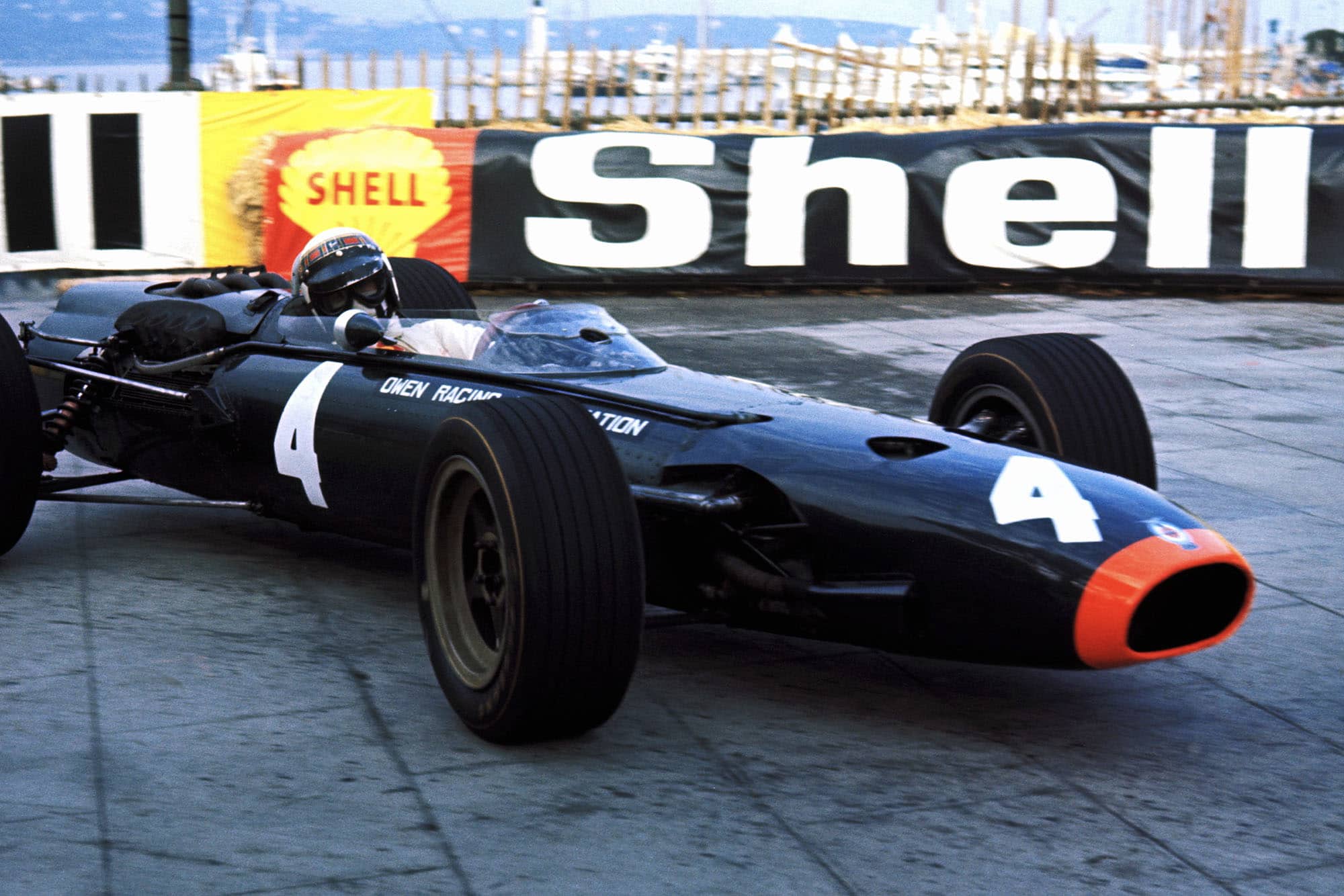
Stewart set the early pace in qualifying
Motorsport Images
While mechanics were checking over the Honda Surtees was concentrating on, he did a few slow laps in the newer car and by the end of the afternoon Stewart, in the V8 BRM was the only one to get below 1min 30.0sec. However, Hulme, Bandini and Gurney were not far behind, though Gurney sheared a welded joint in a drive shaft, fortunately without any damage, but it meant close inspection of the other shaft and of those on Ginther’s car.
Second practice was on Friday morning when most people were thinking about breakfast and this time the whole field were present. the Lotus cars having arrived in the night. All night work by the Brabham team had got the brand new 1967 Repco engine installed in Brabham’s own car, but it had involved a lot of modifying and fabrication and he had to spend this practice period running-in the new engine.
The whole pace of practice was much faster than the day before and a sense of urgency seemed to pervade everyone. Clark was soon setting a furious pace with the Lotus-Climax V8 and Stewart was watching him all the way, but Surtees was getting the Honda going in a most impressive manner. Hulme was still working away with very serious intent as was Hill with the Lotus-B RM V8, but trouble was rife, for Rodriguez had his normal Maserati engine break so his numbers were put on the experimental car with the new engine and he practised with that.
Beltoise had hardly begun to practise when a rear suspension upright collapsed on him as he took a bend in the Casino square, and Courage overdid things and crashed the Parnell BRM 2-litre V8. Bandini opened up a bit too soon at the Mirabeau hairpin and hit the wall, breaking his front suspension, and Stewart came to rest with bolts sheared in the final drive. Gurney had changed cars with Ginther, taking chassis number 103, and got well below 1min 30sec and by the time practice finished and the dust had settled there were quite a lot of repairs needed.
Surtees had made fastest time in an heroic drive with the Honda in 1min 28.4sec and Stewart, Clark, Gurney and Hill had all broken 1min 30sec while many others were not far off. Stewart had done 1min 29.9sec with his H16 BRM in only a very few laps and without making any adjustments so he was beginning to wonder whether he had been concentrating on the wrong car. Siffert was faster with the Walker/Durlacher Cooper-Maserati than both the works cars, which pleased the owners enormously, and he along with McLaren and Gurney seemed assured of a place on the starting grid.
It rained steadily on Saturday morning so it began to look as if Friday’s time would be the fastest, but practice was not due until late afternoon, after two Formula 3 heats and before it began the circuit was nearly dry and the sun was shining again.
“The tempo of practice seemed to start up from where it left off the day before and there was some furious driving going on”
There were no absentees for the mechanics had all slaved away and repaired the ravages of the Friday practice, Bandini’s front end being straightened out, Courage’s BRM being put straight, Rodriguez having another engine installed in his Cooper, Gurney and Ginther changing back to their original cars, the spare Honda having a 1966 gearbox fitted as one of the new ones had broken and Stewart’s BRM transmission was repaired.

Brabham out his eponymous car on pole
Motorsport Images
The tempo of practice seemed to start up from where it left off the day before and there was some furious driving going on, the guaranteed starters trying to get on the front row of the grid and the non-guaranteed trying not to be left out. The Cooper team were not at all happy for the new engine in the Rodriguez car just would not function properly and Rindt hit a kerb “harder than usual” and broke a rear wheel as well as doing extensive damage to the chassis frame.
Graham Hill broke the second gear in his Hewland gearbox and had to wait while his mechanics removed the broken bits and then continue practice without second gear. Bandini was none the worse for his mistake and was going faster than ever, beating the best time of the Honda with 1min 28.3sec, while Clark and Hulme were very close with 1min 28.8sec.
The two Formula 2 Matras were being driven way over the limit to try and qualify among the tail-enders and Anderson equalled the best time put up by Courage with the BRM and actually beat the best time of Amon, but he failed to make the select five by one-tenth of a second.
Gurney was well qualified as was McLaren, but Ginther could not make the running, being slower than Anderson and the two Matras. As practice drew to a close and Anderson, Beltoise and Ginther realised they were not going to start, the wily old Brabham had been gradually extending his new Repco engine and on his very last lap did a fantastic 1min 27.6sec.
While this did not affect Bandini too much, he having been fastest up to this point, it knocked Surtees from the front row and relegated Clark to the third row along with Stewart, so that the first four cars were all full-blooded 3-litres and Hulme was quietly and confidently alongside the Honda on the two-by-two grid.
Race

Bandini leads the field up the hill
Motorsport Images
This year the timekeeper’s box and the start and finish line had been moved from just after the Gasworks hairpin to just before Ste Devote corner so that any last-minute dashes for the finishing line could now take place on the whole length of the pit straight.
Conditions on Sunday were as good as could be desired as the cars lined up for the start, on the old starting grid so that when Chiron dropped the flag the sixteen cars had a flying start over the timekeeper’s line. Stewart in the 2-litre V8 BRM was on Firestone tyres, while the other two BRMs were on Dunlop, the Honda had had an oil cooler fitted to the left side of the new gearbox, Bandini’s Ferrari had the cockpit cover joint to the body sealed with red tape and Amon’s car was sealed with blue tape.
Both Brabhams were still on low-profile 15” Goodyear tyres, Rindt’s Cooper chassis had undergone some major re-riveting during the night, and Hill’s Hewland gearbox had been repaired. Gurney was still driving Eagle number 103 and it had been fitted with a very short nose cowling in case the normal long “beak” got bent in the opening lap scuffle.
It was Bandini who led away and Brabham’s car seemed to hesitate as it took off and as the sixteen cars streamed round the town on the opening lap the new Repco engine broke a connecting rod and when Brabham got to the Mirabeau hairpin he was throwing oil onto his rear tyres from a hole in the block! The engine was still running on seven cylinders and Brabham spun in the middle of the jostling throng and travelled backwards down to the station hairpin while nearly everyone scrambled past safely, the exception being Siffert, who in the process damaged his radiator.
At the end of this exciting opening lap Bandini led from Hulme, Stewart, Surtees and Gurney, while Siffert limped into the pits and had his radiator changed and Brabham arrived to be rather surprised when he saw the hole in his brand new engine. What he did not realise was that he had laid oil on the course, which was being covered by cement dust while the pack were on their second lap.
As the leading bunch approached the “chicane” there was a lot of slipping and sliding about and clouds of cement dust and Clark, who was just behind expected a multiple accident to happen so he deliberately went up the escape road. When he backed out to rejoin the race, everyone had gone and he was all alone at the back of the field of fourteen cars, which almost immediately became thirteen for the Cosworth engine in the Matra of Servoz-Gavin broke its injection unit driving belt.
“Clark expected a multiple accident to happen so he deliberately went up the escape road… when he backed out to rejoin the race, everyone had gone and he was all alone”
During this panic Hulme and Stewart had nipped past Bandini, so the order was now Brabham, BRM, Ferrari, followed by Honda, Eagle and McLaren. Gurney took his Eagle-Weslake past the Honda on the next lap and past the Ferrari on the lap after that, while Hulme was being pressed hard by Stewart.
On lap 5 the Weslake engine broke the toothed belt driving the fuel pump and the Eagle lay stricken by the roadside after a short sharp race. Clark was driving hard to make up time for his error and had already passed Courage and Rodriguez, the Cooper-Maserati running on about ten cylinders by the sound of it.
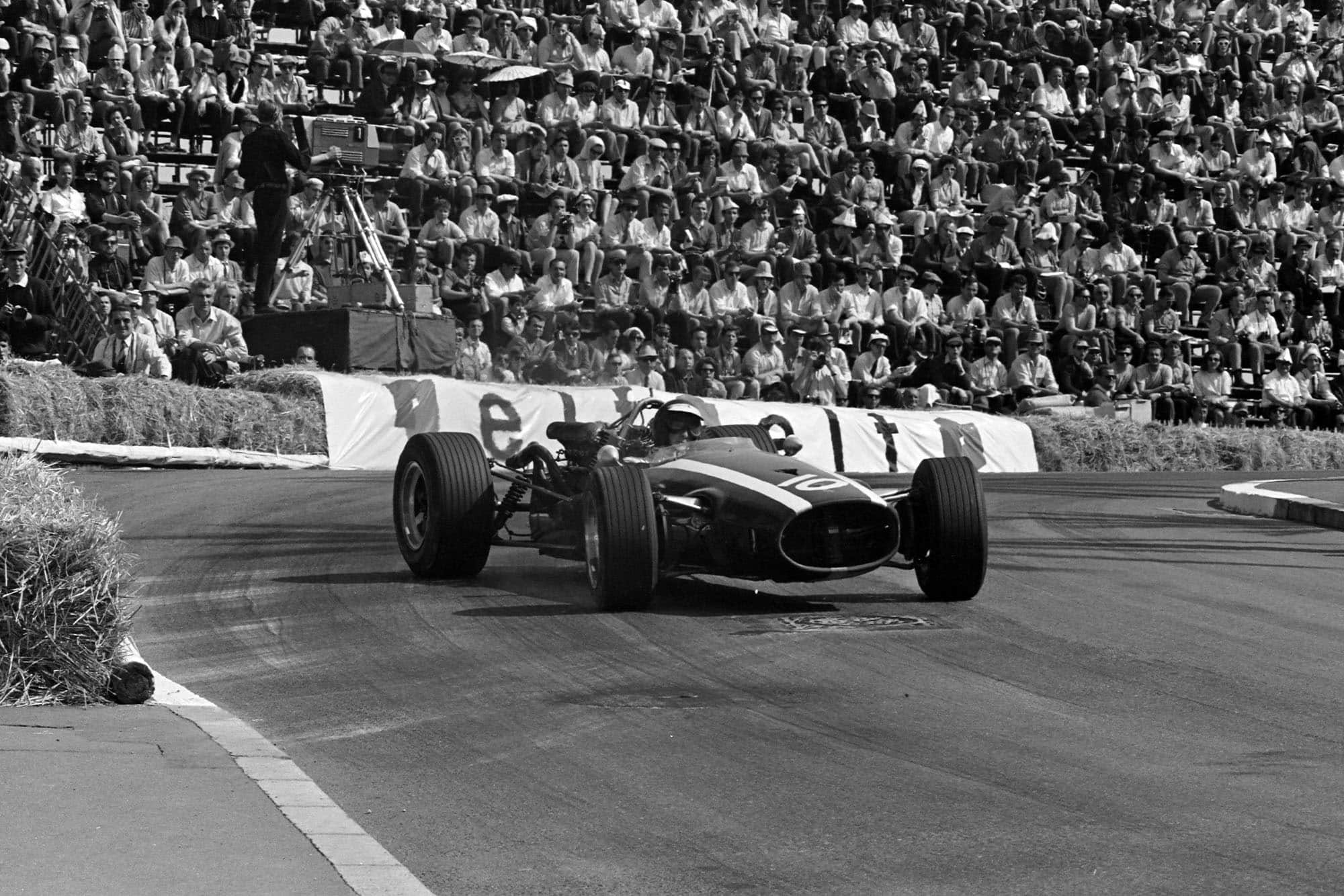
Jochen Rindt was hanging on to the leading group
Motorsport Images
Rindt was hanging on to the leading bunch and got by McLaren for a couple of laps and at the end of the sixth lap Stewart crossed the line alongside Hulme, making his bid for the lead, which came off. The little Scot was in terrific form and Hulme could keep him in sight but not stay with him and a small gap began to appear between the two cars.
Bandini was in third place, with Surtees right behind him, with McLaren and Rindt in the Honda’s wake. This group had already outdistanced the rest of the runners who were being led by Hill in the Lotus-BRM V8, but Amon who was next was about to be caught by Clark, who was making fastest race laps every time round, but nowhere near the lap record as the circuit was still slippery.
At the end of lap 15 Hulme was leading and Stewart was seen travelling slowly along the harbour front, his crown wheel and pinion having broken up and the others went by him as he made slowly for the pits to retire. This put Bandini back into second place, still with Surtees just behind him, followed by McLaren. Rindt had gone out when his gearbox broke up and Clark had caught and passed Hill by this time, though with the drying track everyone had speeded up and Hulme now held the fastest lap at 1min 31.5sec, but it was significant that Clark was the first to appreciate the changing conditions and increase his lap speed.
By 20 laps Hulme was comfortably in the lead with some 15 seconds over Bandini, but Surtees could not get the Honda past the Ferrari and McLaren was still hanging on to them and going extremely well. The Honda was showing signs of tiring and as it went by on lap 27 there was an ominous trail of smoke coming from the engine and on the next lap McLaren took third place from the Japanese car.
Clark was still making fastest laps and as he clocked 1min 30.0sec on lap 28, he caught right up with the ailing Honda and on the next lap Surtees waved him by as they raced down the promenade behind the pits. The smoke from the Honda was getting worse all the time and it was obviously not going to last much longer and it finally succumbed, with suspected broken piston on lap 33, stopping at the “chicane.”
At this point Hulme was rounding Saint Devote corner as Bandini was rounding the Tabac corner, so that there was just twice the length of the promenade between them. Clark was still going as fast as ever and now had his sights on McLaren and third place and by 40 laps he was right behind McLaren, having set up a new lap record on lap 38 in 1min 29.5sec: and only Amon and Hill were still on the same lap as the leading foursome, the Lotus BRM clutch was playing up and Amon had got by on lap 23, but was making no impression on the leaders.
“Hulme was equal to Bandini’s challenge and held his lead to around 8 seconds and it became a trial of strength with the rugged New Zealander coming out on top”
As Clark was completing lap 43 he hurled the Lotus into the Tabac corner and at that moment the right rear spring unit broke and the car spun into the wall and wrecked the rear suspension. Clark climbed out unhurt, but now a spectator, with the small consolation of holding the lap record. Bandini was now beginning to get his second wind and he slowly reduced the gap between the leading Brabham and his Ferrari down to 7 seconds, but Hulme was equal to the challenge and held his lead to around 8 seconds and it became a trial of strength with the rugged New Zealander corning out on top.
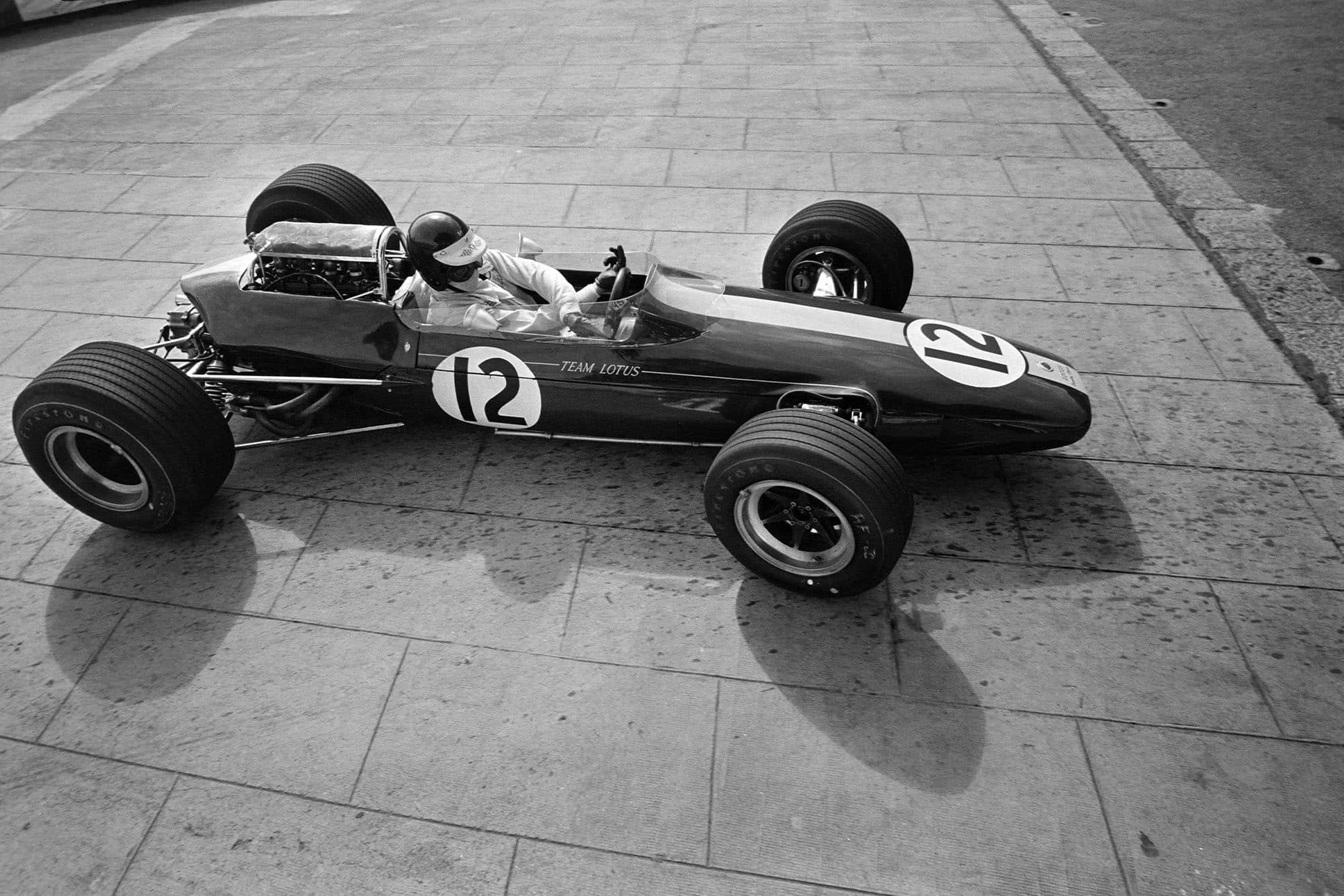
Clark set an electrifying pace before crashing out
Motorsport Images
At 50 laps, which was half-distance, the order was Hulme (Brabham-Repco V8), Bandini (Ferrari V12), McLaren (McLaren-BRM V8), Amon (Ferrari V12) and Hill (Lotus-BRM V8), all still on the same lap, Spence (BRM H16), Rodriguez (Cooper-Maserati V12) and Courage (BRM V8) being well behind, while Siffert was circulating having lost 19 laps while his water system was repaired.
The deadlock between the two leading drivers continued for fifteen laps, with McLaren always in third place and Amon fourth, while Hill was lapped by the leaders. McLaren’s engine began to lose power for his alternator was not balancing the consumption and his battery was running down and affecting the ignition.
By 70 laps the deadlock had been broken, Hulme’s superior physical condition obviously coming out on top and poor Bandini was beginning to flag and he began to show signs of tiredness and lack of concentration, occasionally being untidy and ragged on some corners.
There was a mild panic at Saint Devote at this time, when Courage spun his BRM and could not restart the engine so he had to abandon the car on the footpath, and on lap 71 McLaren’s engine was sounding awful so he pulled into the pits and had a new battery fitted but this dropped him behind Amon and Hill, and two laps behind the leader.
On lap 82 as Bandini took the “chicane” the Ferrari struck the wooden barriers and was immediately out of control. It mounted the straw bales on the outside of the corner, a wheel was broken off, and the car landed upside down in the middle of the road with the driver trapped underneath. Almost instantaneously the car was a sheet of flame and by the time Bandini was extricated from the wreckage he was in a very serious condition, and subsequently died from his burns.
“On lap 82 as Bandini took the chicane the Ferrari struck the wooden barriers and was immediately out of control”
This very nasty incident now left Amon in second place, nearly a lap behind Hulme who was driving as regularly and smoothly as ever, but on lap 91 the Ferrari suffered a punctured rear tyre, probably from running over something near the crash, and Amon wallowed into the pits to have it changed.
This put him behind Hill, but still ahead of McLaren and in that order the race ran to its close at 100 laps. During the confusion of the accident Rodriguez had got his sick Cooper-Maserati ahead of Spence’s H16 BRM, though opinion was sharply divided as to whether this was strictly correct.
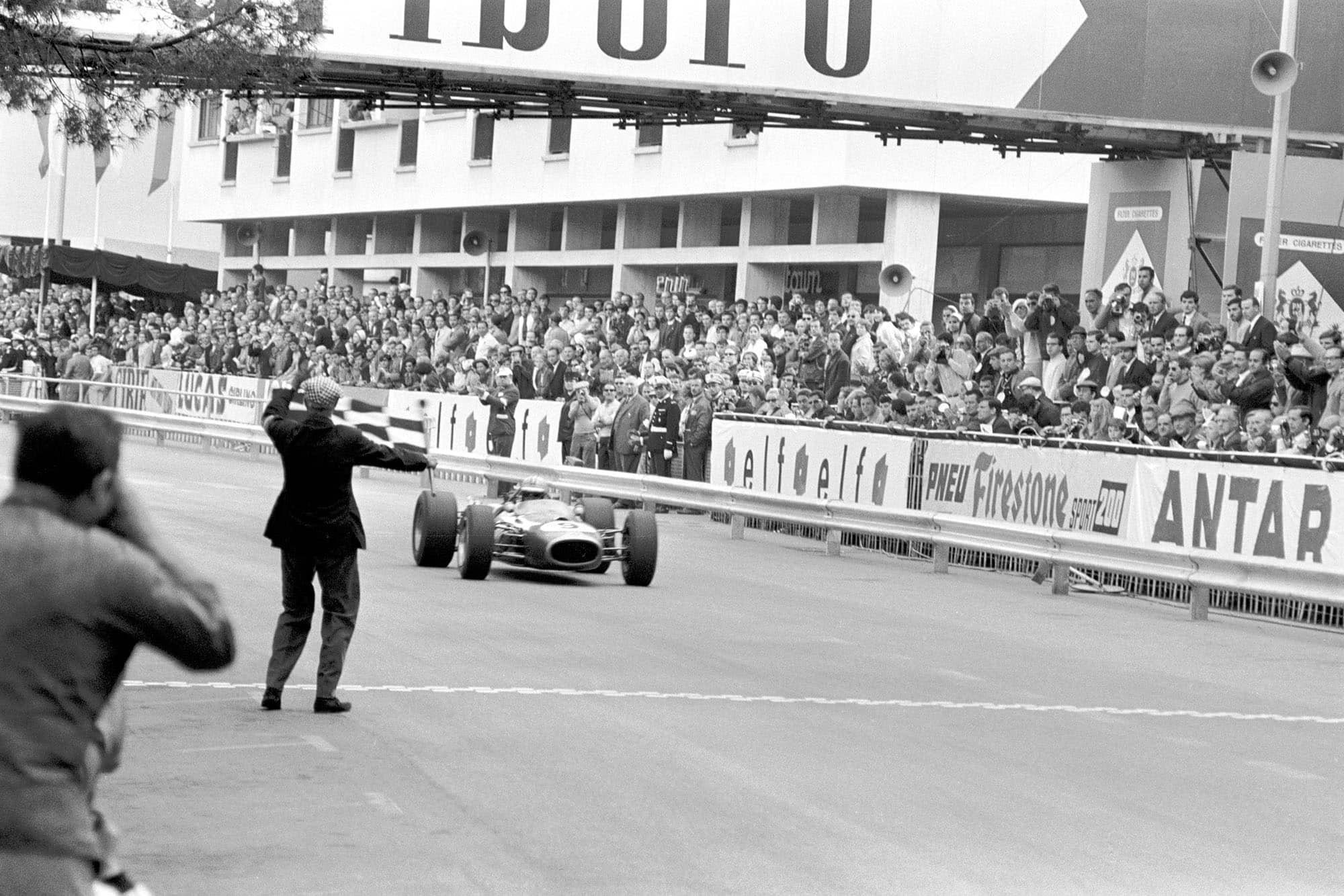
Hulme takes the chequered flag and victory
Motorsport Images
The Cooper had never fired on twelve cylinders all afternoon and the pit were reluctant to bring the car in, as knowing their Maserati engines they were pretty sure it was overheating and would not restart again.
The accident to Bandini threw rather a cloud over the finish of the race and detracted some of the glory that was due to Hulme, for he had driven with the will to win from the very first practice period and had shown outstanding stamina.
Monaco murmurs
- The race was run at a slightly slower average speed than last year, but then Bandini had been pressing the winner right up to the end.
- In the opening phases of the race neither Hill nor Amon was in the picture, yet they finished second and third. The Monaco Grand Prix lived up to its reputation for being unpredictable.
- After hitting the wall at Tobacconist’s Corner Jim Clark was seen helping the marshals to sweep up the bits and pieces before walking back to the pits.
- There were three New Zealand drivers in the first four to finish. The English are losing their grip on Grand Prix racing.
- Exactly a year ago an H16 BRM-engined car did its first practice lap. This year it did 96 laps while the winner did 100 laps and was still running at the end of the race.
Monaco Formula Three
In the usual way a very large entry was accepted for the F3 race on Saturday, before Grand Prix day, and this was divided into two 16-lap heats, the fastest eleven in each heat going into the final. As it was wet for the first heat and dry for the second the line up for the final over 24 laps was a bit muddled. The Matra drivers Jassaud and Pescarolo dominated both heats and final, to the surprise of some people but it must be realised that they have the backing of a powerful team and a large racing department and are works entries, whereas the opposition stemmed from small private teams and private owners. It did not help matters much when a number of the British entry had a multiple accident at the “chicane,” in which Mac Daghorn was injured.
